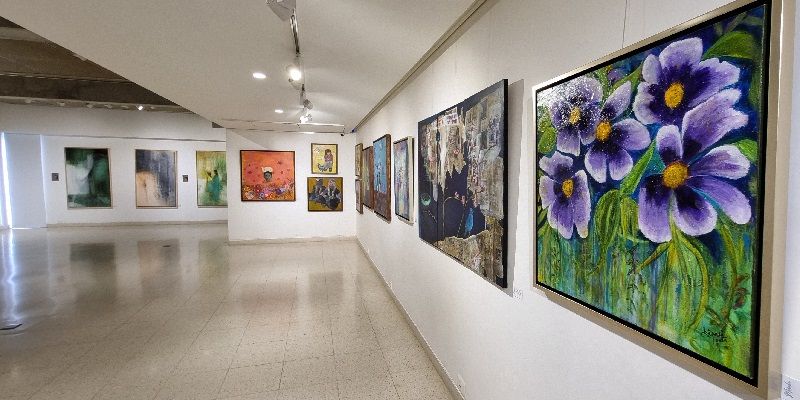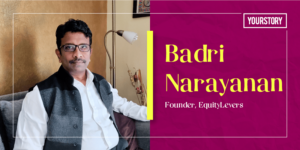Launched in 2014, PhotoSparks is a weekly feature from YourStory, with photographs that celebrate the spirit of creativity and innovation. In the earlier 810 posts, we featured an art festival, cartoon gallery. world music festival, telecom expo, millets fair, climate change expo, wildlife conference, startup festival, Diwali rangoli, and jazz festival.
The Bangalore International Centre recently featured a group show curated by MG Dodammani (see our coverage of earlier exhibitions at this venue here). Titled Meraki (‘essence of yourself’ in Greek), it featured the works of three artists: Neena Jacob, Dipali Gupta, and Manika Srivastav.
In this photo essay, the three artists share insights from their artistic journeys, creative processes, and the meaning of success. They also provide tips for improving art appreciation in society, and advice for aspiring artists.
“The works of these artists reflect the diverse cultures they have encountered around the globe. They reflect beauty, experimentation and confidence,” curator MG Dodammani tells YourStory.

Artistic journeys
Manika Srivastav began with commissioned artworks for friends and families early in her career and during her studies for a Master’s in Physics at Delhi University. “As I started travelling after getting married, I would show my work in informal settings like clubs and coffee shops,” she recalls.
Her first formal show happened when she returned to Delhi in the early 1990s, followed by shows overseas. “My painting never stopped and I would use odd spaces to make studios on stair landings, or in the corners of my room wherever I was, including hotels as we travelled,” she says.
“Moving to Boston stabilised my output and led to solo and group shows in Brookline and Cambridge,” Srivastav adds. Other shows followed, in Houston, Dubai and Bengaluru.
She produces work regularly, sometimes working on more than one piece simultaneously. “On an average, I complete up to ten pieces a year, and I have been doing this for more than 30 years,” she proudly says.

Dipali Gupta was trained under the renowned Iranian master Ali Esmailpour in Singapore, where she was based for the last 16 years. “After much experimentation, I have developed my own unique style over time, which is bold and unorthodox,” she explains.
“Mixed media brings out the best in me as an artist. I find it very expressive and liberating, where you literally break traditional rules of painting and often come up with something unexpected,” she describes.
She also favours collage as a technique. She uses newspapers as a metaphor to describe the unsettling and disturbed world we inhabit. “There is always an underlying subtle message in my work,” Gupta says.
Hailing from Kerala, Neena Jacob describes herself as a semi-abstract figurative artist. “My style of painting, which is influenced by impressionist influences from an early trip to Paris, has a play of light and shadow in most of my work,” she describes.
“I believe in the power of art to drive social change, and have participated in many group shows,” she adds. For example, she was involved in an exhibition for ProVision Asia, which raised funds to provide prosthetics for young children.

The artistic process
“I try to understand the various aspects of the craft by reading and studying different artists. Drawing, sketching, taking photos, and observing are all aspects of my research,” Srivastav says, describing her creative process.
She starts compiling sketches, developing some while discarding others. “I might decide to employ embroidery in the piece, in which case I use thread to create a study,” she explains.
Srivastav wants viewers to engage in the artist’s story, and not just admire a pretty picture and move on. Though she has gone through multiple iterations in her journey, she still feels she has so much to learn.
She generally works on large surfaces. “But a large blank expanse can be intimidating. So I first use a brush to write on the surface, be it meditative words or poetry,” she says.
“This brings the work close to me spiritually and I can start confidently. All these are steps which lead to developing a style that is uniquely mine,” Srivastav adds.

MG Dodammani, Neena Jacob, Dipali Gupta, and Manika Srivastav
Gupta has displayed her work in several art fairs and exhibitions in Singapore, Dubai and India. She also lends her works to charitable causes, and volunteers her time for art-related initiatives.
Her earlier exhibitions include Love in the Pandemic, a set of artworks produced during the lockdown, highlighting the healing power of love during the pandemic. “It was a six-month-long art installation at Gleneagles Hospital in Singapore,” she proudly says.
The flowering trees and petal-strewn lanes of Bengaluru inspired Gupta to create a set of small botanical artworks. Her smaller framed works range in price from Rs 10,000 to Rs 1,20,000.
“These pieces, made of dried foliage and paint on canvas, evoke a simple sentiment of nature and were almost therapeutic to create. It was my ode to the garden city,” Gupta says.

Art appreciation
All the three artists call for greater art appreciation in society. Jacob feels it is important to create art awareness in children and youth by encouraging them to engage with art museums and galleries.
International schools teach basic art knowledge and encourage children to think outside the box. “Museum visits and art camps helped my children in Singapore develop art appreciation from a young age,” Gupta observes
“Volunteering mothers would bring in new ideas from different countries into school art projects. More of that can be done here in India as well. I appreciate the public community art projects and festivals in Bangalore. It is encouraging to see such involvement,” she enthuses.

Meaning and success
Success means different things to each artist. Gupta feels truly appreciated as an artist when her art strikes a chord in someone’s heart. “Selling art is bittersweet. It is almost like sending your baby to its forever home. I must confess I have often gifted my work to those who truly loved it but could not afford it,” she adds.
Srivastav feels success primarily lies in the reactions of people while engaging with her art. “To have people request for the portrait of a loved one or for particular spaces is satisfying. Commercial success is a validation of myself as an artist but also an assurance that the work is valued by the buyer,” she explains.
Having moved around a lot, she was not able to join the traditional path for applying for awards that have residency restrictions, or developing relationships with galleries. “However, my experience in different cultures and exposure to a variety of different circumstances has only enriched my process,” Srivastav says.
Her exhibited works at the Meraki show are a trip down memory lane along with the impressions she retained from observing different faiths across India. Her largest piece, at 60 inches X 100 inches, is priced at Rs 3 lakh. The smaller pieces are priced from Rs 18,000 upward.

“My art is deeply connected to the natural world, often portraying figures and landscapes that reflect the strength of the human spirit,” Jacob says. Her exhibited works include Whispers of dawn and A morning for reflection.
Gupta feels there is no right or wrong in art. “Art is a personal expression and a reflection of the artist’s inner self. It is a limitless journey,” she says.
Artists have to create art for themselves first, and not pander to what the market wants. “Art should be playful and bring you joy while you create it,” she adds.
Gupta feels no regrets for her journey so far. “I celebrate my small wins and have a growth mindset,” she says.

Resilience
The artistic journey is not without its share of twists and challenges. For example, Srivastav had to learn to let go of some canvases which were not working.
“Sometimes I have resorted to actually cutting up the canvas or blocking sections with gesso (plaster). This process has taught me that cutting off a piece of dead thought leads to the growth of new stories,” she describes.
“I have learned not to agonise over a brush stroke or a colour that seems wrong, but to start again. If a path is meandering and not leading to anything, then I abandon it without fear of changing direction,” Srivastav says.

Tips for aspiring artists
The creators also offer a range of tips for aspiring artists. “Being an artist involves consistency and practice, often with ups and downs! But I encourage aspiring artists to practice their craft everyday allowing their passion to emerge through their art,” Jacob suggests.
“Art is beautiful to create, but it is a serious pursuit and can be lonely,” Gupta cautions. “Be clear about your motivations: whether you are looking at it as a career or simply a hobby. Create art for the joy of it and stay intrinsically true to yourself,” she emphasises.
Srivastav advises aspiring artists to do something every day. “Continuity helps achieve discipline. Also, never fall into the trap of comparison as all art is unique. Do not despair if you are not selling, and do not get depressed if you are not finding inspiration,” she urges.
“Draw from an image, copy an old master or just doodle. The act itself will open the door,” she adds. She herself has experienced multiple low points, faced negativity, and even withstood criticism for not having attended art school. But she considers her training under the renowned artists Rameshwar Broota and Shobha Broota to be rewarding.
“Consistency and practice are the key. The best response to challenges is to paint some more,” she signs off.
Now what have you done today to pause in your busy schedule and harness your creative side for a better world?








(All photographs were taken by Madanmohan Rao on location at the gallery.)






![Read more about the article [Funding roundup] Bonatra, Push Sports raise fresh capital](https://blog.digitalsevaa.com/wp-content/uploads/2021/04/VCfunding-1605087354569-300x150.jpg)



